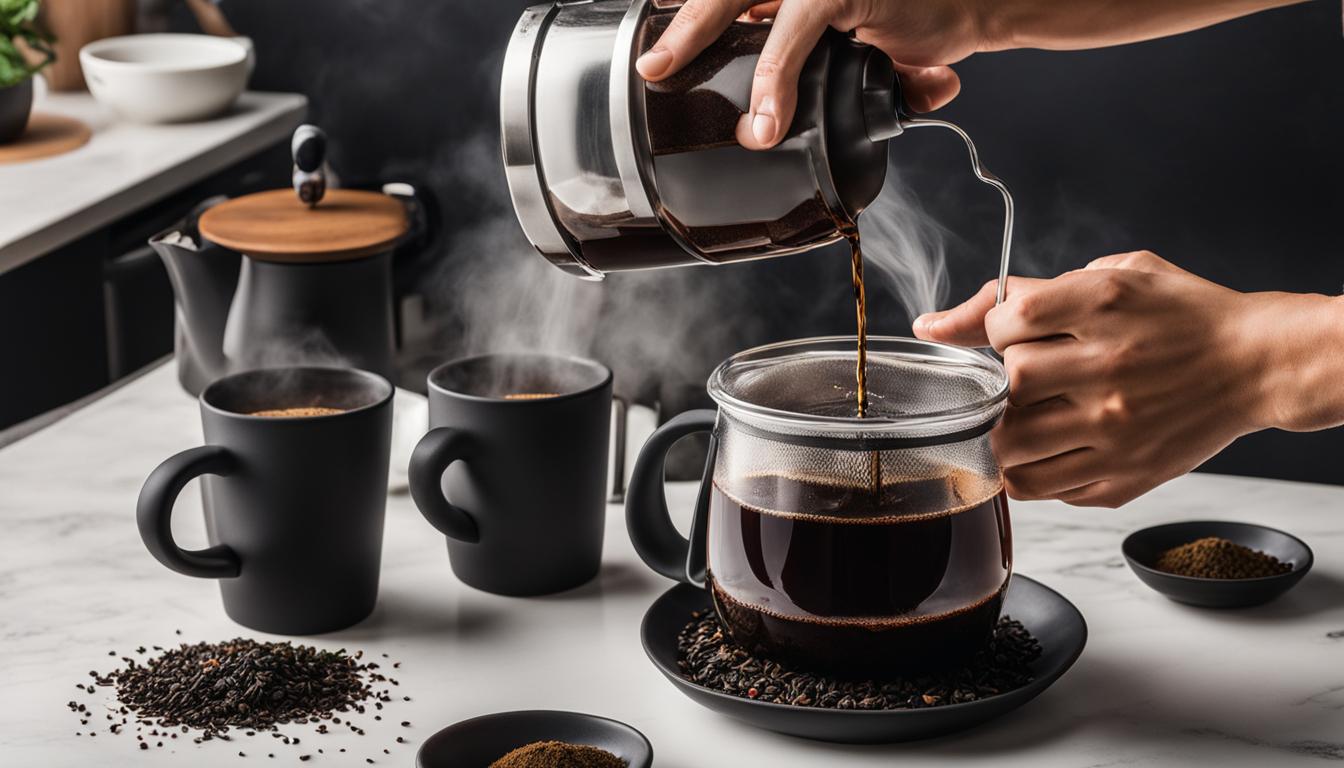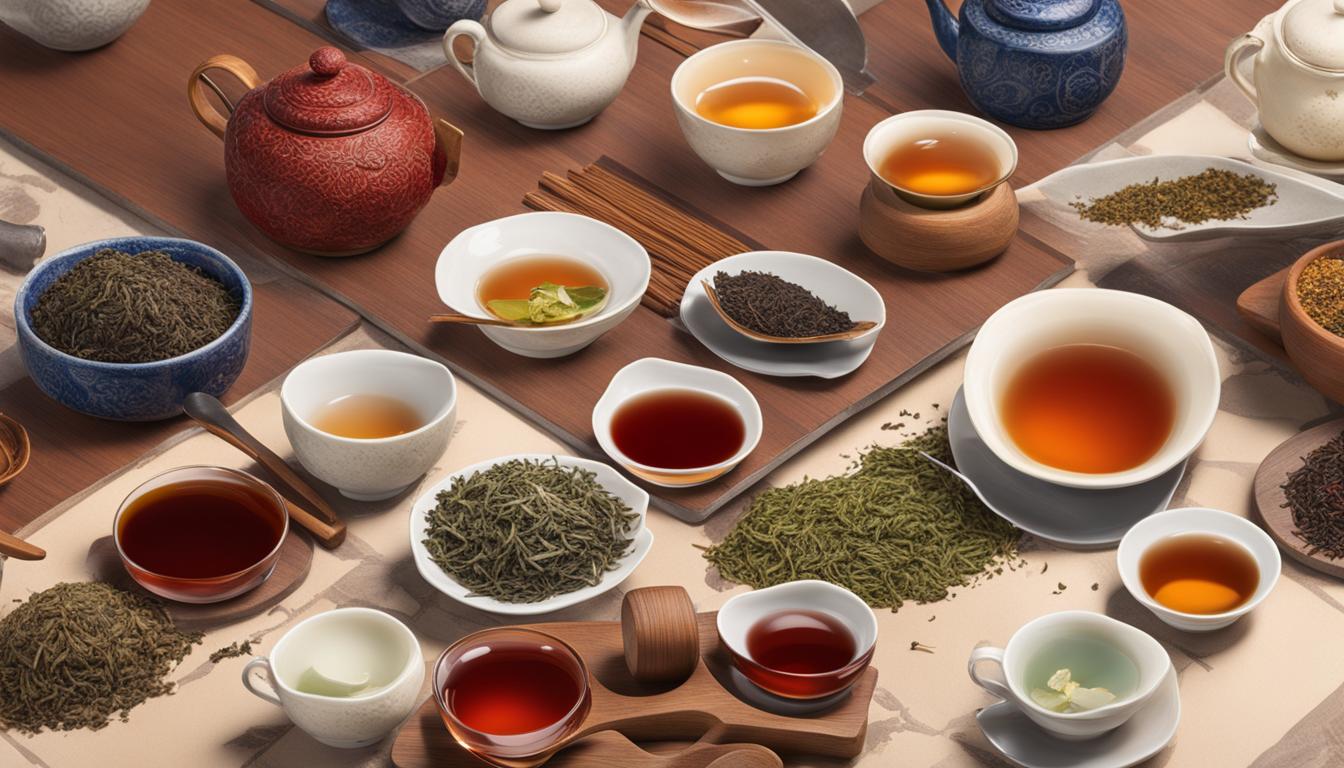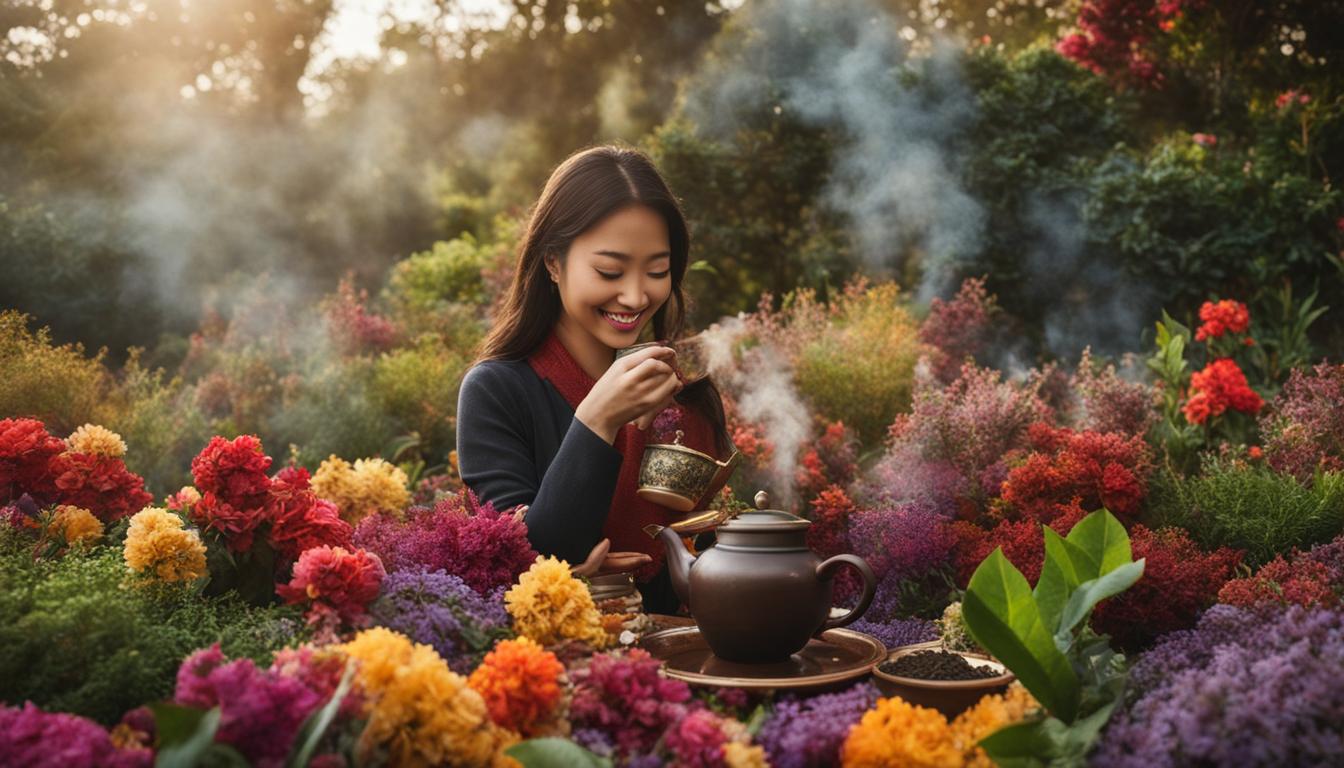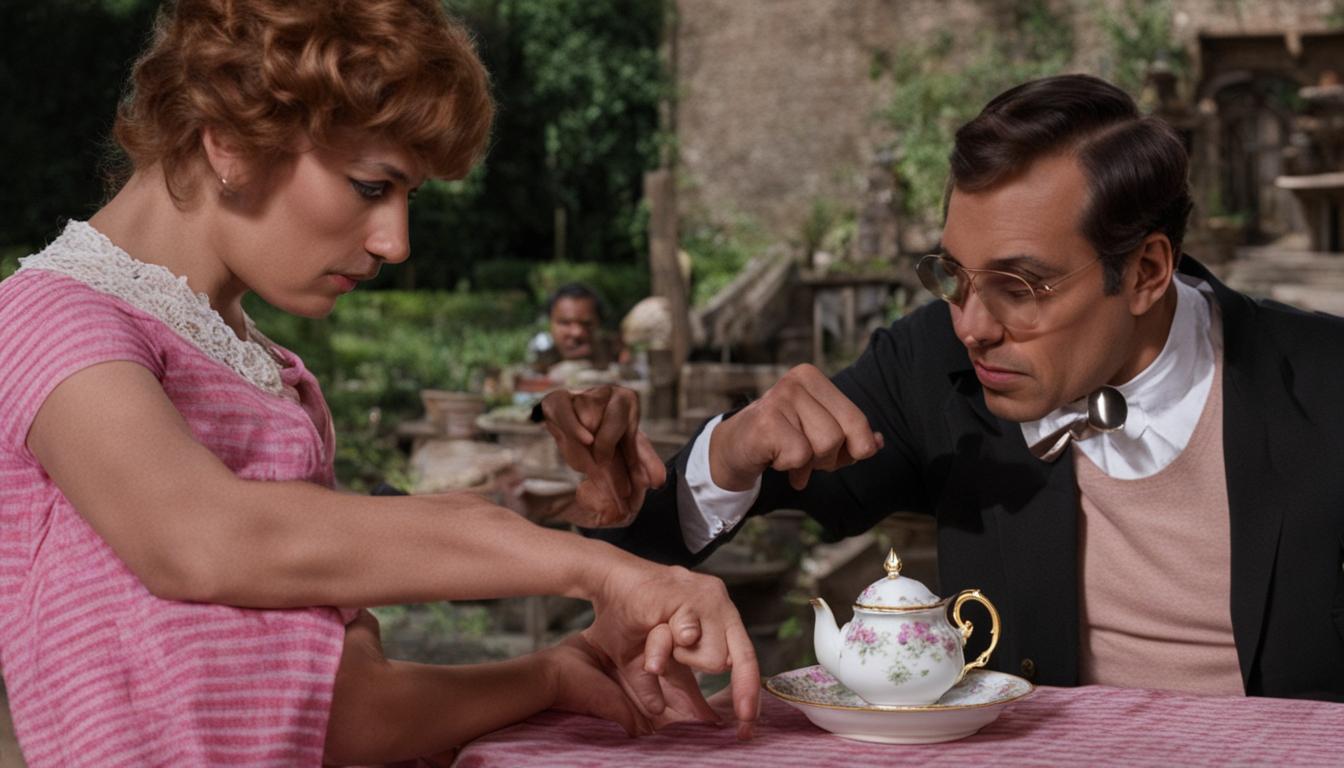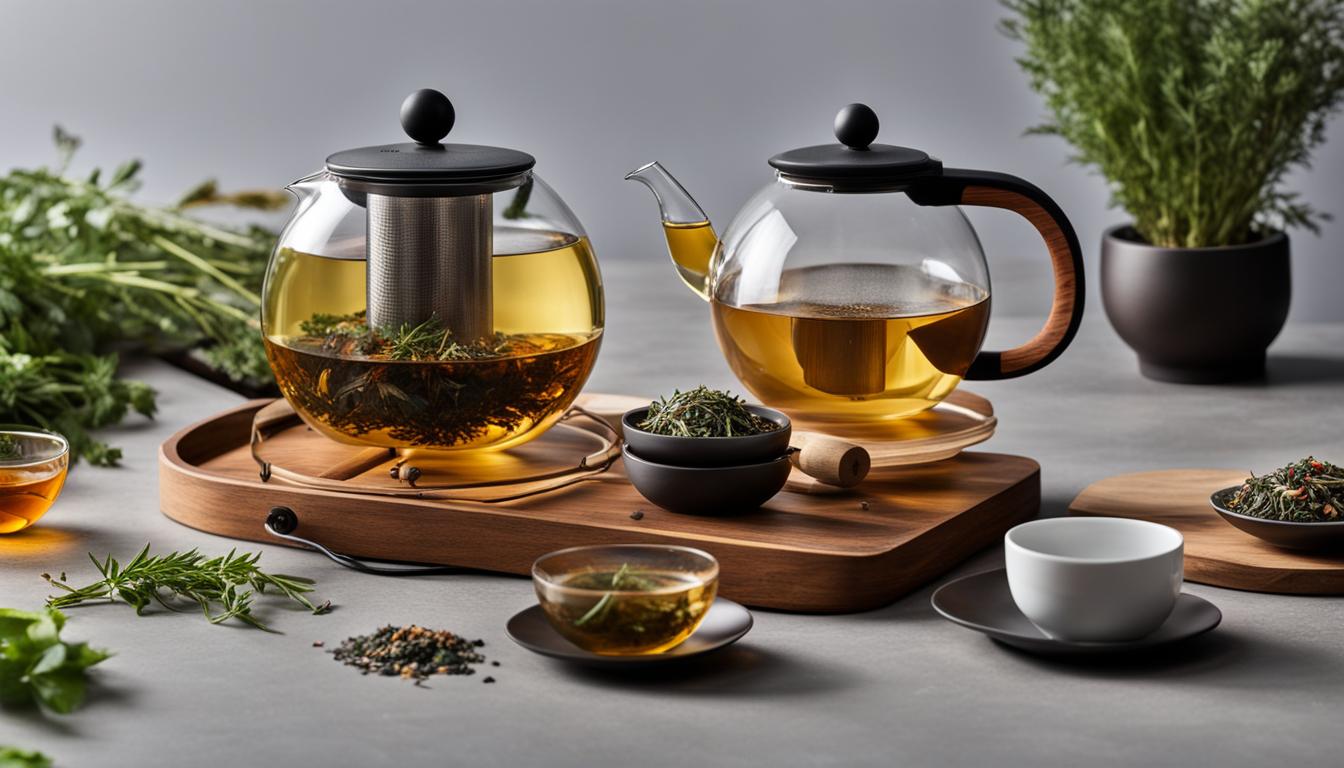When it comes to brewing tea, there are several methods to choose from, each with its own unique advantages and flavor profiles. Two popular options that often come up in the debate are the teapot and the French press. In this article, we’ll compare these two brewing methods to help you decide which one is right for you.
Teapots, also known as tea infusers, are specifically designed for brewing loose-leaf tea. They come in various materials such as heat-resistant glass or plastic and feature a removable lid and a filter or strainer to hold the tea leaves. On the other hand, French presses are primarily designed for coffee but can also be used for brewing tea. They are typically made of glass or stainless steel and feature a plunger and metal mesh filter.
The choice between a teapot and a French press ultimately comes down to the flavor profile you prefer. Teapots tend to produce a more concentrated flavor and a smoother cup of tea, while French presses create a full-bodied and robust tea with a rich aroma.
In terms of appearance, teapots are usually smaller and more compact, made of materials like glass, stainless steel, or ceramic. French presses, on the other hand, are larger and bulkier, typically made of glass or stainless steel. Teapots often have a fine mesh or paper filter, allowing for proper steeping of the tea leaves, while French presses have a larger mesh filter designed for coffee grounds.
Both teapots and French presses have their advantages, so it’s important to consider your needs and preferences. Whether you’re looking for a quick and convenient brewing method, or a more sophisticated and customizable experience, both options can help you achieve the perfect cup of tea.
Key Takeaways:
- Teapots are specifically designed for loose-leaf tea brewing, while French presses are primarily used for coffee but can also brew tea.
- Teapots offer a more concentrated flavor and a smoother cup of tea, while French presses produce a full-bodied, robust tea with a rich aroma.
- Teapots are usually smaller and more compact, while French presses are larger and bulkier.
- Teapots have fine mesh or paper filters for steeping tea leaves, while French presses have larger mesh filters for coffee grounds.
- Consider your needs and preferences when choosing between a teapot and a French press for your tea brewing needs.
The Filtration Methods of Teapot and French Press
When it comes to brewing tea, the filtration methods of Teapots and French Presses play a crucial role in determining the flavor and consistency of the final cup. Let’s take a closer look at how these two brewing methods differ in terms of their unique filtration designs.
Teapot Filtration
Teapots are designed with a focus on precision and control, ensuring a smooth and clear cup of tea. They typically utilize a fine mesh or paper filter to keep loose tea leaves from entering the brewed tea. This meticulous filtration system allows for a refined and refreshing tea experience, free from any undesirable debris or sediment.
French Press Filtration
French Presses, originally intended for coffee brewing, have a distinct filtration mechanism. They employ a metal mesh filter attached to a plunger, which separates the brewed coffee or tea from the grounds. The larger mesh filter of a French Press allows the flavorful oils and compounds to pass through, resulting in a rich and full-bodied cup of tea.
It’s worth noting that the filtration process in a French Press does allow some fine particles to slip through, which can create a slightly thicker mouthfeel compared to tea brewed in a Teapot. This unique characteristic is desired by many tea enthusiasts who appreciate a robust and aromatic tea experience.
When it comes to cleaning and maintenance, Teapots generally have removable lids and filters, making them easier to maintain. French Presses, on the other hand, require more thorough cleaning to remove the coffee grounds or tea leaves from the plunger and filter. Regular maintenance is crucial to preserving the pristine taste and aroma of both Teapot and French Press brewed tea.
| Teapot | French Press | |
|---|---|---|
| Filtration Method | Fine mesh or paper filter | Metal mesh filter attached to a plunger |
| Resulting Tea | Smooth and clear | Full-bodied and aromatic |
| Cleaning and Maintenance | Easier with removable lids and filters | Requires thorough cleaning |
With their distinct filtration methods, both Teapots and French Presses offer unique advantages for tea lovers. Choosing the right brewing method depends on personal preferences and desired flavor profiles. Whether you prioritize a refined, clear cup of tea or a bold and aromatic brew, both Teapots and French Presses can elevate your tea experience to new heights.
Brewing Tea in a French Press: A Step-by-Step Guide
Are you looking to brew tea in a French Press and enjoy a flavorful cup with ease? Look no further! We’ve put together a simple step-by-step guide to help you master the art of brewing tea in a French Press.
Step 1: Prepare Your Ingredients
Gather your favorite loose-leaf tea and fresh, filtered water. The quality of your tea and water will greatly impact the final taste, so choose wisely.
Step 2: Measure and Add Tea
For every 8 ounces of water, use 1 tablespoon of loose-leaf tea. Adjust the amount according to your preferred strength. Place the tea leaves directly into the empty French Press.
Step 3: Heat the Water
Heat the water to the appropriate temperature for your tea type. Refer to our previous section on steeping time and water temperature for different tea types for guidance.
Step 4: Pour and Steep
Slowly pour the heated water over the tea leaves in the French Press. Make sure all the leaves are fully saturated. Place the plunger on top of the French Press but do not press it down just yet. Let the tea steep for the recommended time based on the tea type and desired flavor strength.
Step 5: Press and Serve
Once the desired steeping time is complete, slowly press down the plunger to separate the tea leaves from the brewed tea. Pour the brewed tea into your favorite cup or mug and savor the delicious flavors and aromas.
Now that you know how to brew tea in a French Press, it’s time to put your newfound knowledge into practice. Experiment with different tea varieties and steeping times to find your perfect cup. Enjoy the rich flavors and convenience that brewing tea in a French Press brings!
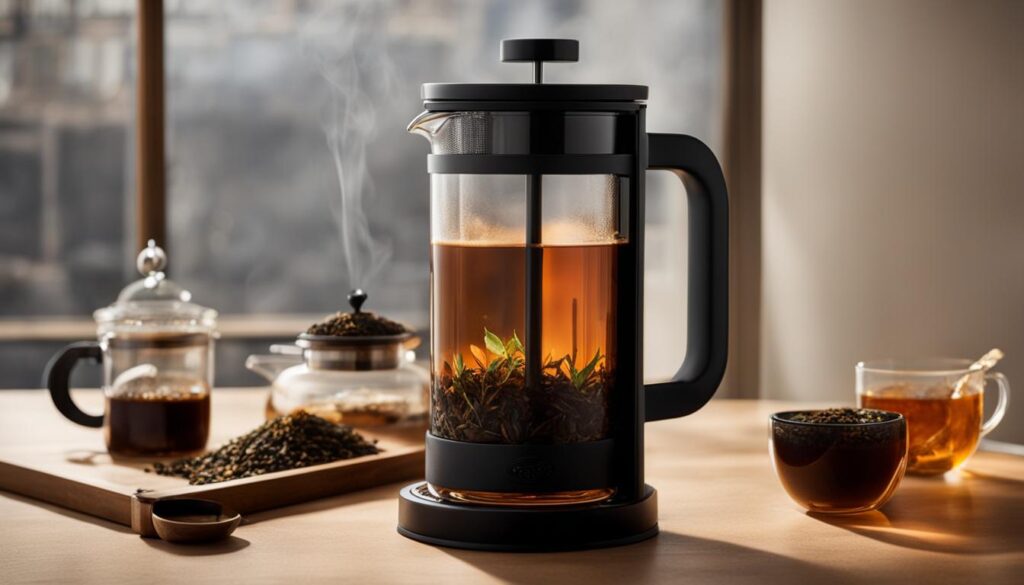
“Brewing tea in a French Press is a delightful way to extract maximum flavor from your tea leaves. The insulated design of some French Presses keeps your tea hot for longer, allowing you to savor your cup at your leisure.”
Steeping Time and Water Temperature for Different Tea Types
When it comes to brewing tea, getting the steeping time and water temperature right is crucial for achieving the perfect flavor. Different types of tea require specific parameters to bring out their unique characteristics and nuances. Here’s a handy guide to help you steep your tea to perfection using either a teapot or a French press:
Black Tea
Black tea is known for its bold and robust flavor. To bring out its full-bodied taste, steep black tea leaves in boiling water for 3 to 5 minutes. Water temperature: 205°F (96°C).
Green Tea
Green tea has a delicate flavor profile that can easily be overpowered if steeped for too long or at high temperatures. Steep green tea leaves in water heated to around 175°F (79°C) for 1 to 3 minutes to achieve a bright and refreshing cup.
Oolong Tea
Oolong tea falls between black and green tea in terms of flavor and oxidation. To bring out its complex and fruity taste, steep oolong tea leaves in water heated to approximately 190°F (88°C) for 3 to 5 minutes.
White Tea
White tea is delicate and subtle, with a light and floral taste. Steep white tea leaves in water heated to around 175°F (79°C) for 2 to 4 minutes to savor its delicate notes.
Herbal Tea and Tisanes
Herbal teas and tisanes encompass a wide range of flavors and ingredients. They are typically more forgiving when it comes to steeping time and water temperature. Boil water and steep herbal tea or tisanes for 5 to 7 minutes, allowing their flavors to fully infuse.
| Tea Type | Steeping Time | Water Temperature |
|---|---|---|
| Black Tea | 3-5 minutes | 205°F (96°C) |
| Green Tea | 1-3 minutes | 175°F (79°C) |
| Oolong Tea | 3-5 minutes | 190°F (88°C) |
| White Tea | 2-4 minutes | 175°F (79°C) |
| Herbal Tea and Tisanes | 5-7 minutes | Boiling water |
Remember, these are general guidelines, and you can adjust the steeping time and water temperature according to your personal taste preferences. Experimentation is key when it comes to finding your perfect cup of tea. Whether you choose to use a teapot or a French press, mastering the art of steeping will elevate your tea brewing experience and allow you to savor every sip.
Pros and Cons of Using a French Press for Tea Brewing
When it comes to brewing tea in a French Press, there are both advantages and disadvantages to consider. Let’s take a closer look at the pros and cons:
Pros:
- Versatility: One of the key advantages of using a French Press for tea brewing is its versatility. While it is primarily designed for coffee, it can also be used to brew a variety of loose-leaf teas.
- Full-bodied flavor: The French Press method allows for a longer steeping time, resulting in a stronger and more robust flavor profile. This is particularly appealing for those who enjoy bold and rich-tasting teas.
- Insulated options: Insulated French Presses are available on the market, which helps to keep your tea hot for longer periods of time. This is perfect for those who like to savor their tea over an extended period.
Cons:
- Sediment in the cup: Compared to other brewing methods, the French Press can sometimes result in a small amount of sediment in the final cup of tea. This can be off-putting for those who prefer a completely clear and smooth brew.
- Difficult to clean: Cleaning a French Press can be more challenging compared to other brewing devices. The plunger and metal mesh filter require thorough cleaning to remove all residue from previous brews.
- Steeping time: French Presses generally require a longer steeping time compared to other methods. This might be inconvenient for those seeking a quick and efficient brewing process.
Ultimately, the decision to use a French Press for tea brewing depends on personal preference and priorities. If you enjoy a full-bodied and robust cup of tea and don’t mind the occasional sediment, a French Press can be a great option. However, if clarity and ease of cleaning are important to you, other brewing methods, like a teapot, may be more suitable.
Now that we’ve explored the pros and cons of using a French Press for tea brewing, let’s move on to the next section, where we will compare the flavor profiles of pour over coffee and French Press brewing.
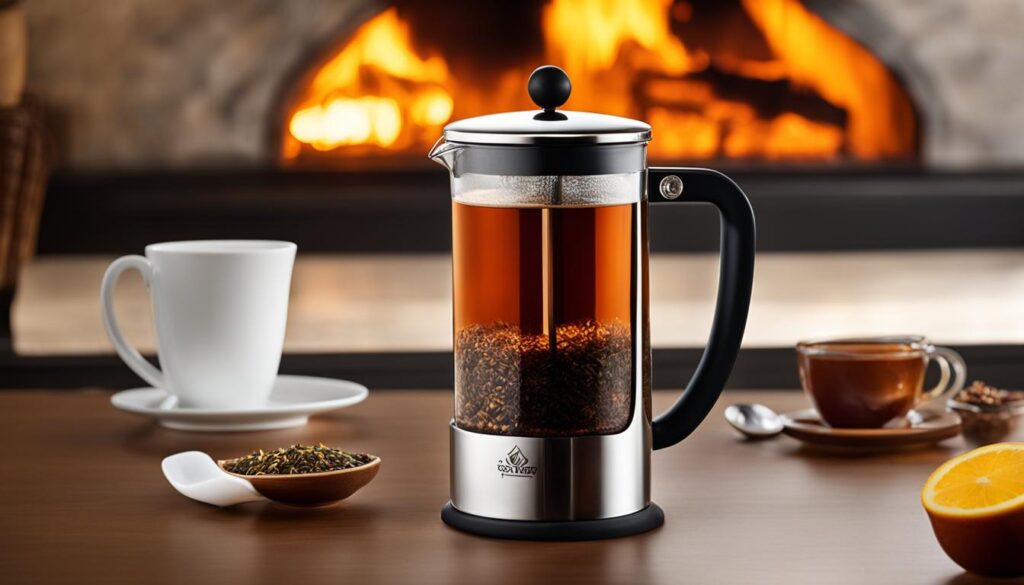
Pour Over Coffee vs. French Press: A Comparison
When it comes to brewing coffee, there are several methods to choose from, each offering a unique flavor profile and brewing experience. Two popular methods that coffee enthusiasts often compare are pour over and French press. Let’s take a closer look at the differences between the two and how they can affect the taste of your coffee.
The Flavor Experience
Pour over coffee is known for its clean and delicate flavor profile. The paper filter used in the pour over method removes much of the coffee oils, resulting in a crisp and refined taste. This method allows for a more pronounced acidity and highlights the subtle nuances of different coffee beans. If you enjoy a lighter and more nuanced cup of coffee with distinct flavor notes, pour over brewing may be the way to go.
On the other hand, French press coffee delivers a bolder and more robust flavor. The metal mesh filter used in a French press allows the coffee oils to pass through, which contributes to a fuller-bodied cup with a thicker mouthfeel. The resulting coffee is rich, aromatic, and often has a stronger taste. If you prefer a full-bodied, strong cup of coffee with a more pronounced mouthfeel, French press brewing might be your preferred method.
Best Teapots for French Press Users
While both pour over and French press require specific equipment, teapots can also be a great option for French press users. Teapots offer a convenient and versatile brewing option, allowing you to brew both coffee and tea in the same vessel. Additionally, teapots come in various sizes and materials, such as glass, stainless steel, and ceramic, providing options to suit different preferences and needs. When choosing a teapot for your French press brewing, consider factors like size, material, and ease of use to ensure the best brewing experience.
| Pour Over | French Press | |
|---|---|---|
| Flavor Profile | Light, clean, and delicate | Bold, robust, and full-bodied |
| Filter | Paper filter removes coffee oils | Metal mesh filter allows oils to pass through |
| Brewing Time | Generally longer due to slower pour | Relatively shorter brewing time |
| Convenience | Requires more attention and manual pouring | Simple and easy to use |
Ultimately, the choice between pour over and French press brewing methods depends on your personal taste preferences and the flavor profile you desire in your cup of coffee. Whether you opt for the delicate and refined flavors of pour over or the bold and aromatic qualities of French press, both methods offer a unique and enjoyable coffee brewing experience. So grab your favorite brewing equipment, experiment with different beans and techniques, and discover the perfect cup of coffee for you.
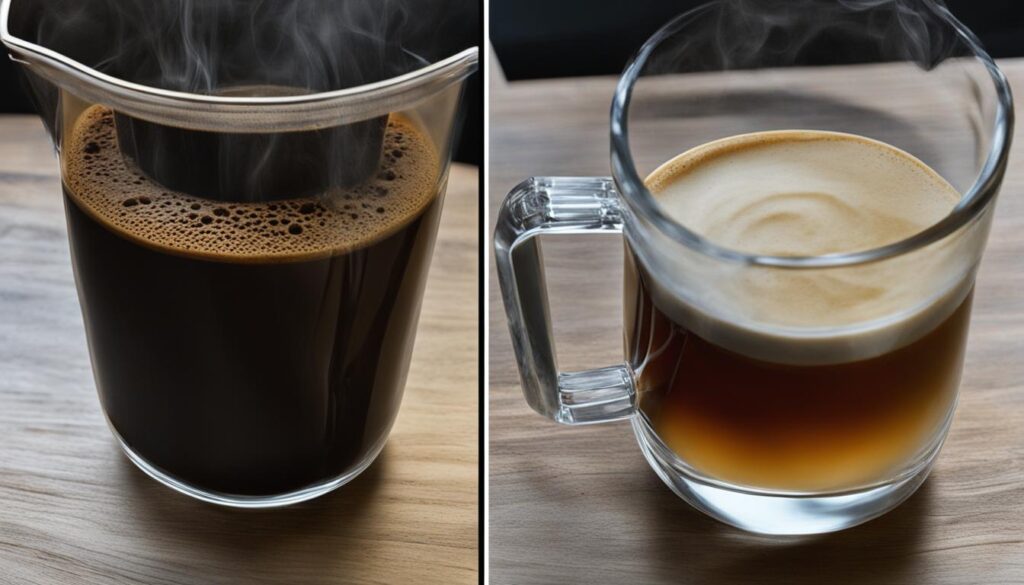
Conclusion
After comparing the brewing methods of Teapots and French Presses, it is clear that both options have their own unique advantages. Teapots are perfect for those seeking a concentrated flavor and a smooth cup of tea, while French Presses excel in producing full-bodied, robust teas with rich aromas.
When it comes to choosing between Teapots and French Presses, it ultimately boils down to personal preference and desired brewing experience. If you prefer convenience and versatility, the French Press may be the perfect option for you. On the other hand, if you crave a more intense flavor profile, a Teapot would be an excellent choice.
Regardless of your preference, both Teapots and French Presses can help you unlock the best flavors for your perfect cup of tea. Don’t be afraid to experiment with different brewing methods and explore the world of tea brewing to discover new flavors and aromas that suit your taste. Cheers to finding your perfect cup of tea!
FAQ
What is the main difference between a teapot and a French Press?
The main difference lies in their design and intended use. A teapot is specifically designed for loose-leaf tea, while a French Press is primarily used for coffee but can also be used for tea brewing.
What materials are teapots and French Presses typically made of?
Teapots are commonly made of heat-resistant glass or plastic, while French Presses are often made of glass or stainless steel.
Do teapots and French Presses have different filtration methods?
Yes, teapots usually have a fine mesh or paper filter to prevent any loose tea leaves from entering the brewed tea, while French Presses use a plunger with a metal mesh filter to separate the brewed tea or coffee from the grounds.
Which brewing method allows for a more concentrated flavor?
Teapots are known for offering a more concentrated flavor and a smoother cup of tea.
Can I use a French Press to brew tea?
Yes, a French Press can be used for brewing tea as well. It produces a full-bodied, robust tea with rich aromas.
How do I clean and maintain a teapot or French Press?
Teapots are generally easier to clean as they have removable lids and filters. French Presses require more thorough cleaning to remove coffee grounds or tea leaves from the plunger and filter.
Which material is better for a French Press?
The choice of material for a French Press depends on factors such as thermal conductivity, tea stains, and personal preferences. Options include ceramic, borosilicate glass, stainless steel, and clay.
What are the advantages and disadvantages of using a French Press for tea brewing?
The pros of using a French Press for tea brewing include the ability to produce a full-bodied, robust tea with rich flavors. However, it requires more thorough cleaning compared to teapots.
How does the flavor of pour over coffee compare to French Press coffee?
Pour over coffee offers a lighter, cleaner cup with subtle flavors, while French Press coffee delivers a robust, full-bodied cup with a stronger aroma and rich oils.

